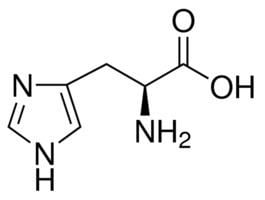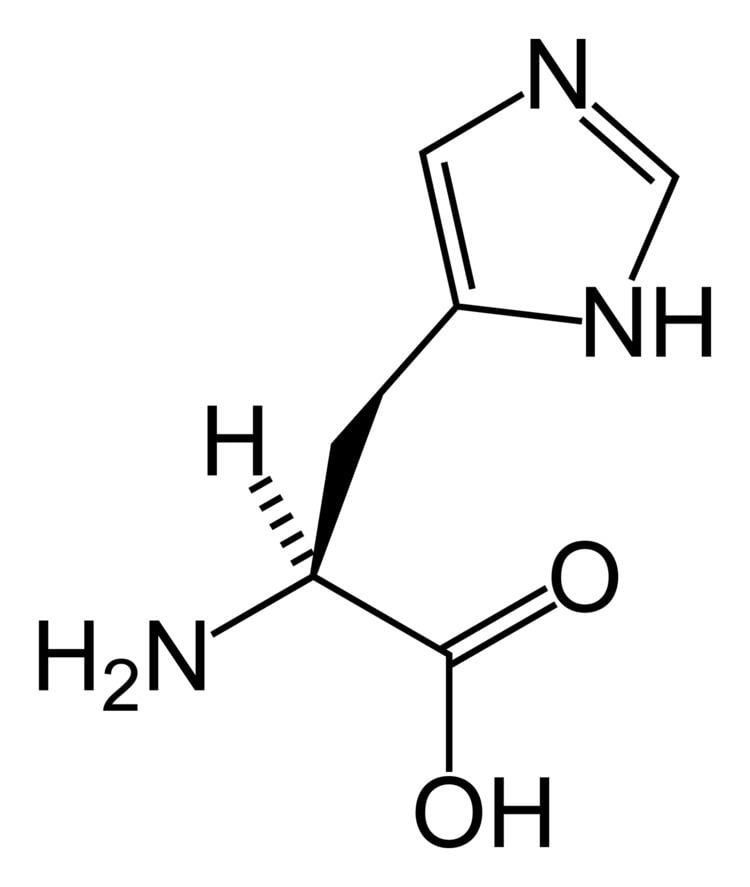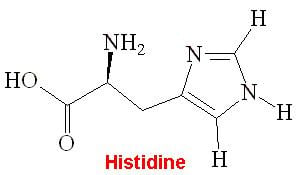Formula C6H9N3O2 | Molar mass 155.1546 g/mol | |
 | ||
Thermodynamicdata Phase behavioursolid–liquid–gas | ||
Special cases histidine proline glycine cysteine mcat khan academy
Histidine (abbreviated as His or H; encoded by the codons CAU and CAC) is an α-amino acid that is used in the biosynthesis of proteins. It contains an α-amino group (which is in the protonated –NH3+ form under biological conditions), a carboxylic acid group (which is in the deprotonated –COO− form under biological conditions), and an imidazole side chain (which is partially protonated), classifying it as a positively charged amino acid at physiological pH. Initially thought essential only for infants, longer-term studies have shown it is essential for adults also.
Contents
- Special cases histidine proline glycine cysteine mcat khan academy
- Special cases histidine proline glycine cysteine
- Chemical properties
- NMR and tautomerism
- Aromaticity
- Biochemistry
- Biosynthesis
- Regulation of biosynthesis
- Degradation
- Conversion to other biologically active amines
- Supplementation
- References

Histidine was first isolated by German physician Albrecht Kossel and Sven Hedin in 1896. It is also a precursor to histamine, a vital inflammatory agent in immune responses. The acyl radical is histidyl.

Special cases histidine proline glycine cysteine
Chemical properties

The conjugate acid (protonated form) of the imidazole side chain in histidine has a pKa of approximately 6.0. This means that, at physiologically relevant pH values, relatively small shifts in pH will change its average charge. Below a pH of 6, the imidazole ring is mostly protonated as described by the Henderson–Hasselbalch equation. When protonated, the imidazole ring bears two NH bonds and has a positive charge. The positive charge is equally distributed between both nitrogens and can be represented with two equally important resonance structures. As the pH increases past approximately 6, one of the protons is lost. The remaining proton of the now-neutral imidazole ring can reside on either nitrogen, giving rise to what are known as the N1-H or N3-H tautomers. The N3-H tautomer, shown in the figure above, is protonated on the #3 nitrogen, farther from the amino acid backbone bearing the amino and carboxyl groups, whereas the N1-H tautomer is protonated on the nitrogen nearer the backbone.
NMR and tautomerism

When both imidazole ring nitrogens are protonated, their 15N chemical shifts are similar (about 200 ppm, relative to nitric acid on the sigma scale, on which increased shielding corresponds to increased chemical shift). NMR shows that the chemical shift of N1-H drops slightly, whereas the chemical shift of N3-H drops considerably (about 190 vs. 145 ppm). This indicates that the N1-H tautomer is preferred, it is presumed due to hydrogen bonding to the neighboring ammonium. The shielding at N3 is substantially reduced due to the second-order paramagnetic effect, which involves a symmetry-allowed interaction between the nitrogen lone pair and the excited π* states of the aromatic ring. As the pH rises above 9, the chemical shifts of N1 and N3 become approximately 185 and 170 ppm. An entirely deprotonated form of the imidazole ring, the imidazolate ion, would be formed only above a pH of 14, and is therefore not physiologically relevant. This change in chemical shifts can be explained by the presumably decreased hydrogen bonding of an amine over an ammonium ion, and the favorable hydrogen bonding between a carboxylate and an NH. This should act to decrease the N1-H tautomer preference.
Aromaticity

The imidazole ring of histidine is aromatic at all pH values. It contains six pi electrons: four from two double bonds and two from a nitrogen lone pair. It can form pi stacking interactions, but is complicated by the positive charge. It does not absorb at 280 nm in either state, but does in the lower UV range more than some amino acids.
Biochemistry
The imidazole sidechain of histidine is a common coordinating ligand in metalloproteins and is a part of catalytic sites in certain enzymes. It has the ability to switch between protonated and unprotonated states, which allows histidine to participate in acid-base catalysis. In catalytic triads, the basic nitrogen of histidine is used to abstract a proton from serine, threonine, or cysteine to activate it as a nucleophile. In a histidine proton shuttle, histidine is used to quickly shuttle protons. It can do this by abstracting a proton with its basic nitrogen to make a positively charged intermediate and then use another molecule, a buffer, to extract the proton from its acidic nitrogen. In carbonic anhydrases, a histidine proton shuttle is utilized to rapidly shuttle protons away from a zinc-bound water molecule to quickly regenerate the active form of the enzyme. Histidine is also important in haemoglobin in helices E and F. Histidine assists in stabilising oxyhaemoglobin and destabilising CO-bound haemoglobin. As a result, carbon monoxide binding is only 200 times stronger in haemoglobin, compared to 20,000 times stronger in free haem.
Biosynthesis
Histidine, also referred to as L-histidine, is an essential amino acid that is not synthesized de novo in humans. Humans and other animals must ingest histidine or histidine-containing proteins. The biosynthesis of histidine has been widely studied in prokaryotes such as E. coli. Histidine synthesis in E. coli involves eight gene products (His1, 2, 3, 4, 5, 6, 7, and 8) and it occurs in ten steps. This is possible because a single gene product has the ability to catalyze more than one reaction. For example, as shown in the pathway, His4 catalyzes 4 different steps in the pathway.
Histidine is synthesized from phosphoribosyl pyrophosphate (PRPP), a biochemical intermediate, which is made from ribose-5-phosphate by ribose-phosphate diphosphokinase during the pentose phosphate pathway. The first reaction of histidine biosynthesis is the condensation of PRPP and adenosine triphosphate (ATP) by the enzyme ATP-phosphoribosyl transferase. ATP-phosphoribosyl tranferase is indicated by His1 in the image. His4 gene product then hydrolyzes the product of the condensation, phosphoribosyl-ATP, producing phosphoribosyl-AMP (PRAMP), which is an irreversible step. His4 then catalyzes the formation of phosphoribosylformiminoAICAR-phosphate, which is then converted to phosphoribulosylformimino-AICAR-P by the His6 gene product. His7 splits phosphoribulosylformimino-AICAR-P to form D-erythro-imidazole-glycerol-phosphate. After, His3 forms imidazole acetol-phosphate releasing water. His5 then makes L-histidinol-phosphate, which is then hydrolyzed by His2 making histidinol. His4 catalyzes the oxidation of L-histidinol to form L-histidinal, an amino aldehyde. In the last step, L-histidinal is converted to L-histidine.
Just like animals and microorganisms, plants need histidine for their growth and development. Microorganisms and plants are similar in that they can synthesize histidine. Both synthesize histidine from the biochemical intermediate phosphoribosyl pyrophosphate. In general, the histidine biosynthesis is very similar in plants and microorganisms.
Regulation of biosynthesis
This pathway requires energy in order to occur therefore, the presence of ATP activates the first enzyme of the pathway, ATP-phosphoribosyl transferase (shown as His1 in the image on the right). ATP-phosphoribosyl transferase is the rate determining enzyme, which is regulated through feedback inhibition meaning that it is inhibited in the presence of the product, histidine.
Degradation
Histidine is one of the amino acids that can be converted to intermediates of the tricarboxylic acid (TCA) cycle. Histidine along with other amino acids such as, proline and arginine, takes part in deamination, a process in which its amino group is removed. In prokaryotes, histidine is first converted to urocanate by histidase. Then, urocanase converts urocanate to 4-imidazolone-5-propionate. Imidazolonepropionase catalyzes the reaction to form formiminoglutamate (FIGLU) from 4-imidazolone-5-propionate. The formimino group is transferred to tetrahydrofolate, and the remaining five carbons form glutamate. Overall, these reactions result in the formation of glutamate and ammonia. Glutamate can then be deaminated by glutamate dehydrogenase or transaminated to form α-ketoglutarate.
Conversion to other biologically active amines
Supplementation
Supplementation of histidine has been shown to cause rapid zinc excretion in rats with an excretion rate 3 to 6 times normal.
